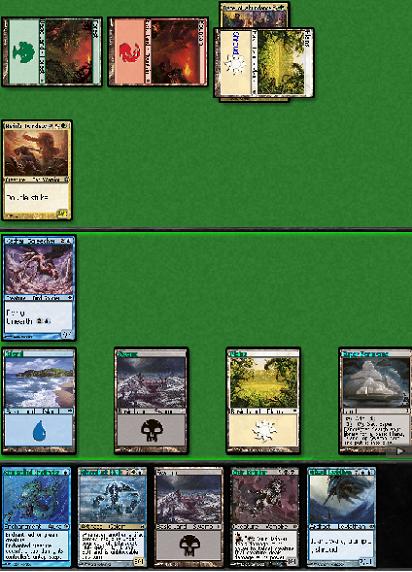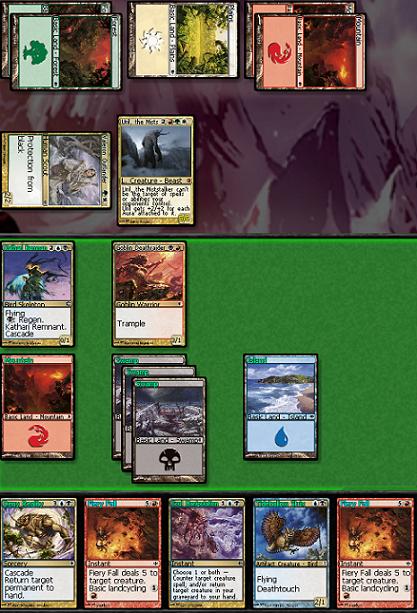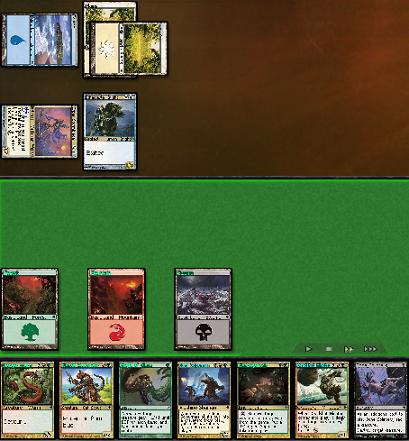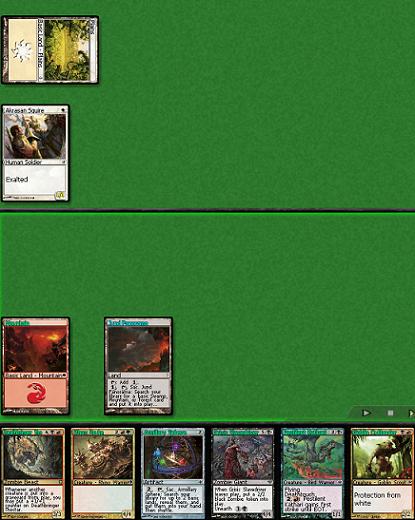I’ve followed my plan, and since returning from Hawaii I’ve been drafting at least twice a day, usually substantially more than that, particularly since my drafts lately haven’t been taking as long as I’d like. I started out doing very well, and toward the end of last week hit a bit of a rough patch. I haven’t come up with a system for recording results that I particularly like for Limited. I tried listing what I was playing and what my opponent were playing by archetype, which works fairly well for this format, and shows some good trends (particularly for what archetypes I’ve been ending up in), but lately I haven’t really been bothering with it.
Instead, I’m going to focus on what is probably the most underutilized tool available to most players: Magic Online replays. At the time of writing this I am also guilty of not taking advantage of this amazing tool, but I’m about to fix that.
I won two drafts today, so my most recent games are more favorable. While I think it’s more useful to look for mistakes in games you’ve lost, as that’s where you need to change something, I would guess that watching replays of wins is valuable in its own way. Specifically, we tend to think more about what we could have done differently in games we lost, so they naturally get reviewed better in our heads. Taking time to review a win is therefore more likely to yield a result that you never would have come to otherwise.
My most recent games were with a five-color deck that played out really well. In the first few games I’ve watched, the only mistake I saw was an incorrect block that resulted in taking a bit of unnecessary damage and leaving the wrong creature alive, but it wasn’t very important. The lesson from this deck is more an example of a five-color deck that works, since I haven’t exactly figured out how I like to draft that deck.
The only two-mana spell in this deck was Worldly Counsel. I had 3 Panoramas, 2 basic land cyclers, and 4 Reborn creature land cyclers. I spent my second turn every game fixing my mana. I played 16 lands, one Obelisk, and a Shard Convergence in that deck. I frequently got to the point where there were very few lands left in my deck fairly early. The mana worked amazingly well, and I actually wonder if I should have played 15 lands.
The deck worked because I had a lot of late game bombs (Hellkite Overlord, Enigma Sphinx, Spearbreaker Behemoth, Extractor Demon, Vengeful Rebirth) and some big midgame creatures (Matca Rioters, Spellbreaker Behemoth) to stabilize with enough removal and good mana. I don’t want to force the deck; I moved into it after getting passed the Hellkite and the Spearbreaker. Excellent finishers are required. The deck is slow enough that I had to beat Battlegrace Angel, Rafiq of the Many, and Finest Hour, so the power level had to be very high.
The draft before that was a forgettable Jund deck that lost in the first round. My first pick of the draft was Violent Ultimatum over Savage Lands and Soul’s Fire, and that worked out very poorly. I ended up with almost no fixing (just 2 Borderposts), and my mana basically didn’t work. I had to play some bad cards over some good cards to give myself a slightly higher chance of casting spells, but the result was a mediocre deck with bad mana and bad spells. I lost my first game to a flier I couldn’t deal with, and a lack of Red mana. The second game was more interesting. He led with Borderpost into Esper Stormblade, which I couldn’t deal with until I drew an Ember Weaver while at 11 life. By that point he had played a Kederekt Creeper, but I had Necrogenesis to stabilize. Eventually I had pretty thoroughly stabilized. He had no hand and I was at 1 life, but I had a Jungle Weaver to hold off his Stormblade and I was about to kill him with Necrogenesis tokens. He drew Sedraxis Alchemist to bounce my Jungle Weaver and kill me.
The lesson from this deck is that I need to prioritize fixing extremely highly in balanced three-color decks, which has been the lesson most of the time I’ve been solid Jund. More importantly, I’ve lost a lot of drafts recently in extremely close games where things fell exactly such that my opponent could kill me rather than the other way around. Particularly, this has happened a lot to my Jund decks. I could continue to reason that my luck with these decks should change, and they’ve generally been fine decks that got themselves into winning positions, but I think it’s better to realize that these decks are all pretty average and they all let themselves get into close situations where they can easily lose if something doesn’t come together quite right. I should try to avoid these decks.
The draft before that I won with an aggressive U/W/b deck with a lot of fliers. These decks have been playing very well against me, and I was pretty happy with this one. I took Esper Shieldmages over Esper Stormblades early in pack 3 and I was happy with the result. There was one game that was very needlessly awkward because I forgot to play a land I’d been planning to play on turn 6, but my opponent gave the game back to me by playing too conservatively (not killing me on board because he gave me credit for removal that I didn’t have).
The draft before that I had a pretty weak Esper deck where things didn’t really go the way I wanted in the draft. In the first game I didn’t play a Controlled Instincts on his Marisi’s Twinclaws because it was untapped on my fourth turn, but I had a Glassdust Hulk and a Vein Drinker than I needed to be playing the next two turns, so I needed to just play the enchantment on his guy while it was untapped.

On his turn he played a Bloodbraid Elf which put me far enough behind that I had to spend my turn playing the Controlled Instincts.
That spiraled into a huge tempo loss that forced me to take a lot of extra damage and make some chump blocks. Eventually I lost the game to Progenitus, which likely would have beaten me anyway, and I ended up losing the match in a third game in which I didn’t have quite enough mana to function. This was kind of a “plan ahead”/”don’t be greedy” moment.
The draft before that I had an excellent Grixis cascade deck with a lot of removal and double Kathari Remnant, which worked excellently as a way to build card advantage and help with inevitability in my control deck. Unfortunately I lost to a pro-Black creature; Uril, the Miststalker; and Mage Slayer, though I probably could have won if I had cycled one of my Fiery Falls to get the 6th land to play the other to deal with the pro-Black creature, and if I had played Tidehollow Strix to trade with Uril rather than counting on my Kathari Remnant to block, which works poorly when I plan to tap out, and even worse when he has Mage Slayer.

This was another instance of poor planning in which I really needed to take time to sculpt how my next few turns were going to play out to avoid losing. The previous game I lost because I mulliganed to five and was only able to deal with one of his two pro-Black creatures, as my deck was very largely Black.
The round before that I had beaten another control deck that had almost no creatures, so despite his Lavalanching me every game, he couldn’t kill me in two of them because I had more removal than he had creatures and eventually won.
The draft before that I had an excellent Jund deck and I kept a hand I almost certainly shouldn’t have. On the play I had Forest, Swamp, Scarland Thrinax, Bloodhall Ooze, Ember Weaver, Goblin Razerunners, and Sangrite Backlash. My deck had four Mountains and four other ways to get Red mana.

This hand needed Red mana and it needed lands, and it needed them faster than I really had time to expect to draw them, particularly given that I was on the play. On the draw, I think it’s worth thinking about. As is, I drew Vein Drinker, then Ember Weaver, then Blood Cultist, while he killed me with two Esper Stormblades and an Esper Cormorants.
The first game of the match he was on the play and I kept Forest, Swamp, Jund Panorama, Gorger Wurm, Nacatl Outlander, Might of Alara, Jund Sojourners. My first draws were Necrogenesis and then Deadshot Minotaur. His first plays were Esper Stormblade and Ethercaste Knight, so I was going to take a lot of damage while I set up. I used my Jund Panorama on turn 2 and on turn 3 I played Nacatl Outlander rather than Jund Sojourners, which was a huge mistake.

He attacked me down to 12 and I played a Forest and then my Jund Sojourners the following turn. If I had played them on turn 3 I could have used Bone Splinters to sac the Sojourners and kill both of his creatures, and then played the Outlander. On his turn he attacked for another 4, putting me to 8, and passed. I played Ember Weaver and he Offering to Asha’d it, which it’s possible that he had the previous turn and could have played if I had played properly. With that countered, I used the Bone Splinters to make the play I should have been able to make the previous turn and stabilized at 8. He played Esper Cormorants and things were looking very good when I drew my 5th land to kill it with a Deadshot Minotaur, but he still had plenty of life and followed up with another Esper Stormblade. I played Gorger Wurm and attacked, and he played a Stormcaller’s Boon, which turned on his Esper Stormblade and gave him an Esper Sojourners, and he attacked me to 5, threatening lethal next turn. At this point I attacked with everything, which should force him to block and leave him unable to kill me, but he had an Unsummon for my Gorger Wurm. I had no removal, but I had drawn Suicidal Charge, which I played to stop him from killing me on his turn. He attacked and put me to two, and then played Wall of Reverence, one of the only single creatures that would stop me from killing him on my turn, and killed me the next turn. This was one of those games where it felt like everything had to go exactly right for my opponent to win and like my deck was probably good enough, and again, based on my misplay on turn 3, maybe it was, but I’ve had enough bad experiences with Jund now that I think I need to at least find a better way to approach it.
Before that I had a similar near loss with a different Jund deck against a different UW deck (this is what I was saying about my opponents having done well with UW). This was a very interesting game. My opening hand was Mountain, Jund Panorama, Armillary Sphere, Pestilent Kathari, Rhox Brute, Grixis Slavedriver, Deathbringer Thoctar. Not the fastest hand, but certainly powerful, and very much what was expected out of my triple Armillary Sphere plus powerful spells deck. I was on the play, so it should be fast enough. I played Mountain and he played Akrasan Squire. On the second turn I drew Goblin Outlander and faced an interesting decision.

If I play Jund Panorama and activate it I can get Goblin Outlander down on turn 3, but if I play Armillary Sphere I can activate it one turn 3 to avoid missing a land drop. I decided that I wanted defense against the Akrasan Squire and activated the Jund Panorama, which I believe lost me the game. He played a Deft Duelist and I played my goblin, drawing a Deadshot Minotaur rather than a land, and then he started playing fliers. I had a hand full of cards that were good against fliers, as I drew Ember Weaver to go with my Minotaur and Kathari, but I was too far behind on lands and had to spend too much time with the Sphere. If instead I’d taken damage from his first creatures to hit my land drops, my Deadshot Minotaur and other powerful spells almost certainly would have been able to take that game for me. Perhaps I should be blaming myself more than these decks.
Before that there was a match where my mediocre Naya deck lost to another Naya deck that was probably better than mine. I’ve been trying to watch to see if any cards stand out in the replays, and in this one Manaforce Mace, a card I’ve generally avoided playing, continued to disappoint, so I won’t be changing my habit on that one.
Periodically reviewing games seems like an extremely healthy habit, which is particularly useful to keep in mind when you’ve just played a game that felt like it could have gone differently. I’m not sure that it’s as revolutionary as I’d hoped, but it may have convinced me to keep trying Jund as long as I’m more careful about my development.
Some more general conclusions from my recent work on Limited: I don’t like GW or RB. In general I want to be some kind of Esper, RGx, or five-color with really exceptional bombs and mana. I’ve been staying away from Bant and Grixis, but I think there may be some hope for Grixis. I need to focus on fixing and removal more than I do. I think I tend to lean slightly too heavily toward good creatures over removal. Sangrite Backlash versus Gorger Wurm comes to mind as a frequent example. I should probably take Sangrite Backlash more often than I do.
For now, I’ll be continuing my work on drafting while taking advantage of the extra QPs for playing Constructed online in the coming weeks. I’m really looking forward to M10… I think the changes should be very interesting for Standard, and I like the direction they seem to be taking it. Also, as much as I think I’ll lose regularly to it, Red really needed Lightning Bolt.
Thanks for reading…
Sam

